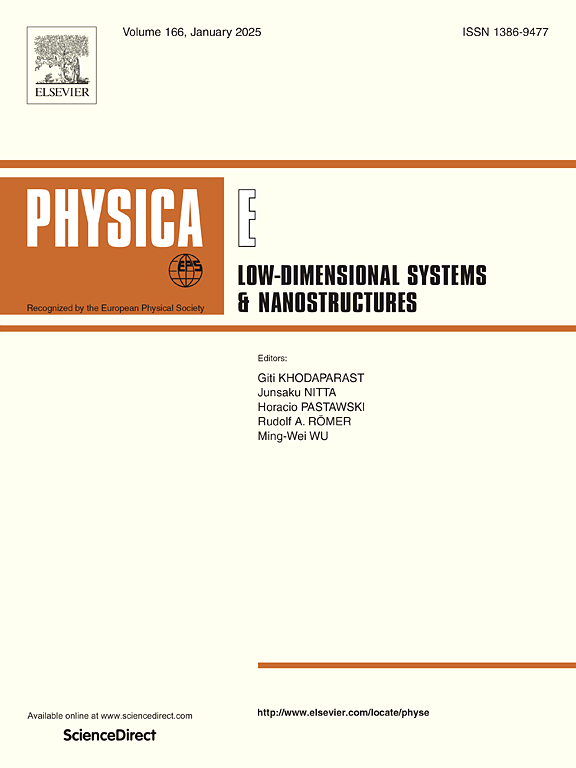Photonic modes in twisted graphene nanoribbons
IF 2.9
3区 物理与天体物理
Q3 NANOSCIENCE & NANOTECHNOLOGY
Physica E-low-dimensional Systems & Nanostructures
Pub Date : 2024-11-08
DOI:10.1016/j.physe.2024.116146
引用次数: 0
Abstract
This study investigates the behavior of photonic modes in twisted graphene nanoribbons (TGNRs) using an analytical approach based on solving the fully covariant vector boson equation. We present a model that demonstrates how helical twisting in TGNRs significantly affects the evolution of photonic modes. Our analytical solutions yield detailed expressions for mode profiles, energy spectra, and decay characteristics. We find that increasing the twist parameter shortens the decay times () for damped modes, indicating enhanced photonic coupling due to the twisted geometry. Conversely, longer nanoribbons (NRs) exhibit increased decay times, showing a length ()-dependent effect, where , with representing the speed of light. These findings may enhance the understanding of light control in nanostructures and suggest potential applications in tunable photonic devices, topological photonics, and quantum optical systems.
扭曲石墨烯纳米带中的光子模式
本研究采用基于求解全协变矢量玻色子方程的分析方法,研究了扭曲石墨烯纳米带(TGNR)中的光子模式行为。我们提出的模型证明了 TGNR 中的螺旋扭曲如何显著影响光子模式的演化。我们的分析解得出了模式剖面、能谱和衰变特性的详细表达式。我们发现,增加扭曲参数会缩短阻尼模式的衰减时间(τns),这表明扭曲几何形状增强了光子耦合。相反,较长的纳米带(NR)的衰减时间会增加,显示出长度(L)依赖效应,其中τns∝L/c,c代表光速。这些发现可以加深人们对纳米结构中光控制的理解,并为可调谐光子器件、拓扑光子学和量子光学系统的潜在应用提供了建议。
本文章由计算机程序翻译,如有差异,请以英文原文为准。
求助全文
约1分钟内获得全文
求助全文
来源期刊
CiteScore
7.30
自引率
6.10%
发文量
356
审稿时长
65 days
期刊介绍:
Physica E: Low-dimensional systems and nanostructures contains papers and invited review articles on the fundamental and applied aspects of physics in low-dimensional electron systems, in semiconductor heterostructures, oxide interfaces, quantum wells and superlattices, quantum wires and dots, novel quantum states of matter such as topological insulators, and Weyl semimetals.
Both theoretical and experimental contributions are invited. Topics suitable for publication in this journal include spin related phenomena, optical and transport properties, many-body effects, integer and fractional quantum Hall effects, quantum spin Hall effect, single electron effects and devices, Majorana fermions, and other novel phenomena.
Keywords:
• topological insulators/superconductors, majorana fermions, Wyel semimetals;
• quantum and neuromorphic computing/quantum information physics and devices based on low dimensional systems;
• layered superconductivity, low dimensional systems with superconducting proximity effect;
• 2D materials such as transition metal dichalcogenides;
• oxide heterostructures including ZnO, SrTiO3 etc;
• carbon nanostructures (graphene, carbon nanotubes, diamond NV center, etc.)
• quantum wells and superlattices;
• quantum Hall effect, quantum spin Hall effect, quantum anomalous Hall effect;
• optical- and phonons-related phenomena;
• magnetic-semiconductor structures;
• charge/spin-, magnon-, skyrmion-, Cooper pair- and majorana fermion- transport and tunneling;
• ultra-fast nonlinear optical phenomena;
• novel devices and applications (such as high performance sensor, solar cell, etc);
• novel growth and fabrication techniques for nanostructures

 求助内容:
求助内容: 应助结果提醒方式:
应助结果提醒方式:


